 W
WThe Bahia heart-tongued frog is a species of frog in the family Hylidae endemic to Brazil. Its natural habitats are subtropical or tropical moist lowland forests, subtropical or tropical moist shrubland, and heavily degraded former forests. It is threatened by habitat loss.
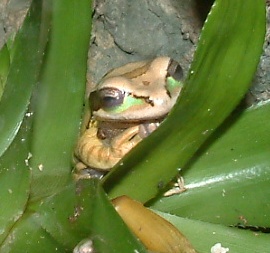 W
WThe blue-spotted Mexican tree frog is a species of frogs in the family Hylidae found on the Atlantic slopes of southeastern Mexico, Belize, and Guatemala, between Jalapa de Díaz in Mexico and Sierra del Mico in Guatemala. Its natural habitats are humid mid-altitude and montane forests, and it can also occur in secondary forest. Breeding takes place in temporary pools and streams and in depressions in logs that fill up with water. It is threatened by habitat loss and, potentially, chytridiomycosis.
 W
WThe Brazilian heart-tongued frog is a species of frog in the family Hylidae endemic to Brazil. Its natural habitat is subtropical or tropical moist lowland forests. It is threatened by habitat loss.
 W
WThe Ceiba stream frog is a species of frog in the family Hylidae endemic to Honduras. Its natural habitats are subtropical or tropical moist lowland forests, subtropical or tropical moist montane forests, and rivers. It is threatened by habitat loss.
 W
WThe common Chinese tree frog (Chinese Traditional: 中國雨蛙 Chinese Simplified: 中国雨蛙 Pinyin: Zhōngguó yǔwā) is a species of frog in the family Hylidae found in southeastern and eastern China and in Taiwan. There is also one record from Vietnam but it is uncertain whether it really represents this species or Hyla annectans.
 W
WThe Copan stream frog is a species of frogs in the family Hylidae found in Guatemala, Honduras, Nicaragua, and possibly El Salvador. Its natural habitats are subtropical or tropical moist lowland forests, subtropical or tropical moist montane forests, rivers, pastureland, and heavily degraded former forests. It is threatened by habitat loss.
 W
WCope's brown treefrog or fringe-limbed treefrog is a species of frog in the family Hylidae. It is found in Costa Rica, Nicaragua, and Panama. Its natural habitats are subtropical or tropical moist lowland forests and subtropical or tropical moist montane forests. It is threatened by habitat loss.
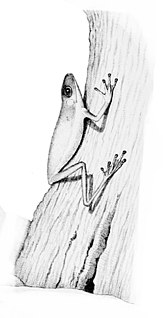 W
WThe Costa Rica brook frog or red-eyed stream frog is a species of frog in the family Hylidae found in Costa Rica and Panama. Its natural habitats are tropical moist lowland forests, subtropical or tropical moist montane forests, and rivers.
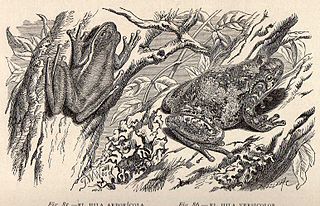 W
WDryophytes arboricola, commonly known as the arboreal treefrog, is a species of frog in the family Hylidae endemic to the Sierra Madre del Sur in Guerrero state, Mexico.
 W
WDryophytes eximius, commonly known as the mountain tree frog, is a species of frog in the family Hylidae endemic to Mexico. Its natural habitats are mesquite grasslands, scrub forests, and pine-oak forests. It is a widely distributed species that faces no major threats.
 W
WDryophytes gratiosus, commonly known as the barking tree frog, is a species of tree frog endemic to the south-eastern United States.
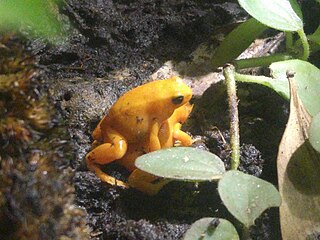 W
WThe dwarf Mexican tree frog is a species of frog in the family Hylidae endemic to Mexico. Its natural habitats are subtropical or tropical dry forests, intermittent rivers, and intermittent freshwater marshes. It is threatened by habitat loss.
 W
WExerodonta is a genus of frogs in the family Hylidae. This genus was resurrected in 2005 following a major revision of the Hylidae. Eleven species previously placed in the genus Hyla were moved to this genus. They are endemic to south-central Mexico.
 W
WExerodonta catracha is a species of frog in the family Hylidae. It is endemic to Honduras. Its natural habitats are subtropical or tropical moist montane forests, rivers, and freshwater marshes. It is threatened by habitat loss.
 W
WThe fairy tree frog is a species of frog in the family Hylidae endemic to Mexico. Its natural habitats are subtropical or tropical moist lowland forests, subtropical or tropical moist montane forests, and rivers. It is threatened by habitat loss.
 W
WHallowell's tree frog is a species of frog in the family Hylidae.
 W
WHyla molleri, also known as the Iberian tree frog or Moller's tree frog, is a species of frog in the family Hylidae, endemic to the Iberian Peninsula and southwesternmost France. It was formerly treated as a subspecies of Hyla arborea, but was split based on genetic differences. The specific name molleri honours Adolphe F. Moller (1842–1920), a Portuguese botanist.
 W
WHyla savignyi, also known as the Savigny's treefrog, lemon-yellow tree frog, and Middle East tree frog, is a species of frog in the family Hylidae. The species is endemic to the Middle East including Israel, where it has been declared an endangered species.
 W
WHylinae is the largest subfamily of the family Hylidae, the "tree frogs". It contains nearly 700 species in 41 genera. They are generally found in North and South America, Europe, temperate Asia, and Africa north of the Sahara.
 W
WIsthmohyla is a genus of frogs in the family Hylidae. This genus was erected in 2005 following a major revision of the Hylidae. The 15 species in this genus were previously placed in the genus Hyla. They are endemic to Central America in Honduras, Costa Rica, and Panama.
 W
WThe Japanese tree frog is a species of tree frog distributed from Hokkaidō to Yakushima in Japan and from Korea along the Ussuri River to north-eastern China, northern Mongolia, and the southern parts of the Russian Far East.
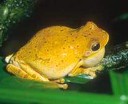 W
WThe mahogany tree frog is a species of frog in the family Hylidae found in Belize, Costa Rica, Guatemala, Honduras, Mexico, and Nicaragua.
 W
WThe Mexican burrowing tree frog is a genus of frogs in the family Hylidae found in Mexico, southern Texas and Arizona, Central America, and northwestern South America. In a recent revision of the Hylidae, the two species of the previous genus Pternohyla were included in this genus. Its name is from the Ancient Greek smiliskos, referring to the pointed frontoparietal processes.
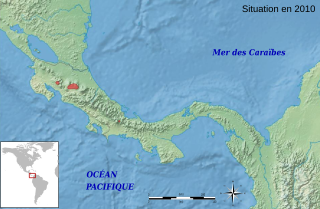 W
WThe narrow-lined tree frog is a species of frogs in the family Hylidae found in the mountains of Costa Rica and western Panama. Its natural habitats are humid lower montane rainforests. It is a nocturnal species that breeds in small puddles and water-filled depressions.
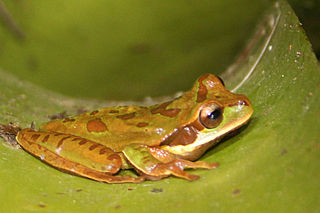 W
WThe New Granada cross-banded tree frog is a species of frog in the family Hylidae found in Colombia, Costa Rica, Ecuador, Honduras, Nicaragua, and Panama. Its natural habitats are subtropical or tropical dry forest, subtropical or tropical moist lowland forest, rivers, freshwater marshes, intermittent freshwater marshes, plantations, rural gardens, urban areas, heavily degraded former forests, ponds, and canals and ditches.
 W
WThe Nicaragua cross-banded tree frog or tawny smilisca, Smilisca puma, is a species of tree frog in the family Hylidae. It is found in the Caribbean lowlands of Costa Rica and adjacent Nicaragua to about 520 m (1,710 ft) above sea level. Its natural habitats are tropical moist lowland forests. It breeds in small, shallow temporary pools or ponds, including those in very disturbed habitats, such as pastures. Males call during the rainy season from shallow water and low bushes. Habitat loss and degradation caused by small- and large-scale agriculture and logging are threats to this species.
 W
WThe painted tree frog is a species of frog in the family Hylidae found in Belize, Guatemala, Honduras, and Mexico. Its natural habitats are subtropical or tropical dry forests, subtropical or tropical moist lowland forests, freshwater marshes, intermittent freshwater marshes, pastureland, plantations, rural gardens, heavily degraded former forests, ponds, and canals and ditches.
 W
WPhyllodytes edelmoi is a species of frog in the family Hylidae endemic to Brazil. Its natural habitats are subtropical or tropical moist lowland forests and rocky areas. It is threatened by habitat loss.
 W
WPhyllodytes maculosus is a species of frogs in the family Hylidae endemic to Brazil.
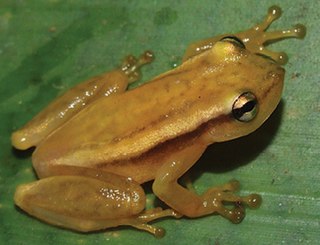 W
WPhyllodytes wuchereri is a species of frog in the family Hylidae endemic to Brazil. Its natural habitat is subtropical or tropical moist lowland forests. It is threatened by habitat loss.
 W
WPlectrohyla acanthodes is a species of frog in the family Hylidae. It is found in Guatemala and Mexico. Its natural habitats are subtropical or tropical moist montane forests and rivers. It is threatened by habitat loss.
 W
WPlectrohyla dasypus is a species of frog in the family Hylidae. It is endemic to the Sierra de Omoa in the Cortés Department of northwestern Honduras. The species range is within the Cusuco National Park.
 W
WPlectrohyla exquisita is a species of frogs in the family Hylidae. Before its description in 1998, it was confused with Plectrohyla teuchestes. It is endemic to the Sierra de Omoa in the Cortés Department of northwestern Honduras. The species range is within the Cusuco National Park.
 W
WPlectrohyla sagorum is a species of frog in the family Hylidae. It is found in the Sierra Madre de Chiapas from Chiapas (Mexico) to southwestern Guatemala, with a single record from northwestern El Salvador. Its natural habitats are cloud forests at elevations of 1,000–2,050 m (3,280–6,730 ft) above sea level. Breeding takes place in streams. It is very rare in Mexico and El Salvador but abundant at two Guatemalan sites. It is threatened by habitat loss. Chytridiomycosis might also be a threat.
 W
WPlectrohyla teuchestes is a species of frog in the family Hylidae. It is endemic to Guatemala and only known with certainty from its type locality on the southern slope of the Sierra de Xucaneb, in the Alta Verapaz Department. There is also a report from another locality in Alta Verapaz. Frogs from Honduras now known as Plectrohyla exquisita were formerly included in this species.
 W
WPtychohyla is a genus of frogs in the family Hylidae. These frogs are found in the southern Mexican states of Chiapas, Guerrero, and Oaxaca, and Central America to western Panama.
 W
WPtychohyla salvadorensis is a species of frog in the family Hylidae found in El Salvador, Guatemala, and Honduras. Its natural habitats are subtropical or tropical moist montane forests, rivers, pastureland, and heavily degraded former forests. It is threatened by habitat loss.
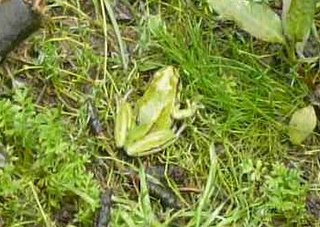 W
WThe ridged tree frog is a species of frog in the family Hylidae endemic to Mexico. Its natural habitats include mountainous pine-fir forests in high elevations. In lower elevations it is known to inhabit moderate and low-lying streams and ponds where it is believed to breed.
 W
WThe Sardinian tree frog or Tyrrhenian tree frog is a species of frog in the family Hylidae, found in Corsica, Sardinia, and the Tuscan Archipelago.
 W
WThe Shensi tree frog is a species of frog in the family Hylidae endemic to China. Its natural habitats are temperate shrubland, rivers, intermittent rivers, swamps, freshwater marshes, intermittent freshwater marshes, and irrigated land. It is threatened by habitat loss.
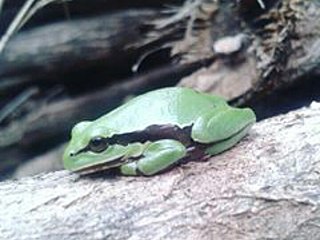 W
WThe southern highland tree frog is a species of frog in the family Hylidae endemic to Mexico. Its natural habitats are subtropical or tropical moist montane forests, subtropical or tropical high-altitude grassland, intermittent rivers, and intermittent freshwater marshes. It is threatened by habitat loss.
 W
WSpikethumb frogs are a genus (Plectrohyla) of frogs in the family Hylidae found in Central America from southern Mexico through Guatemala and northern El Salvador to central and northern Honduras. A major revision of the Hylidae moved an additional 21 species to this genus from the genus Hyla. They are called spikethumb because of the spike on their thumbs, which is called a prepollex. The genus name comes from the Greek word plēktron ("spur") and hyla.
 W
WThe Kaieteur Tepui treefrog is a species of frog in the family Hylidae endemic to Guyana. This species is known only from the type locality, which is given as "Kaieteur Falls, 366 m asl, Mazaruni-Potaro District, Guyana". It might occur more widely.
 W
WTlalocohyla is a genus of frogs in the family Hylidae, also known as rain treefrogs or Middle American yellow-bellied treefrogs. They occur in Middle America between Mexico and Costa Rica. This genus was created in 2005 following a major revision of the Hylidae. The four species in this genus were previously placed in the genus Hyla.
 W
WTriprion is a genus of frogs in the family Hylidae found in the Pacific lowlands of Mexico, the Yucatán Peninsula, and Guatemala. These frogs hide in tree-holes and plug the entrance with their strange-looking, bony heads.
 W
WTriprion petasatus is a species of frog in the family Hylidae found in Belize, Guatemala, Honduras, and Mexico. Its natural habitats are subtropical or tropical dry forests, moist savanna, freshwater marshes, intermittent freshwater marshes, rural gardens, heavily degraded former forests, aquaculture ponds, and canals and ditches.
 W
WThe Veragua cross-banded tree frog is a species of frog in the family Hylidae found in Colombia, Costa Rica, Honduras, Nicaragua, and Panama. Its natural habitats are subtropical or tropical moist lowland forests, subtropical or tropical moist montane forests, rivers, plantations, rural gardens, urban areas, heavily degraded former forests, and canals and ditches.
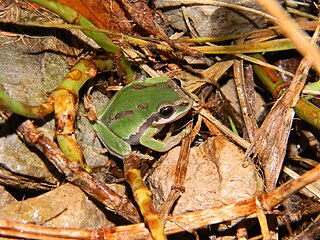 W
WWalker's tree frog is a species of frog in the family Hylidae found in Guatemala and Mexico. Its natural habitats are highlands of pine-oak forests and pine-fir forests. It is known to occur in Chiapas Mexico and in parts of Guatemala including the Sierra de los Cuchumatanes mountain range in the west, the plateaus of central Guatemala, and in southeastern Guatemala. However, it is believed that its range is greater than what is currently known. It breeds in temporary ponds, and is threatened by habitat loss.
 W
WWright's mountain tree frog is a species of frog in the family Hylidae found in Mexico and the United States. Its natural habitats are temperate forests, temperate grassland, rivers, and freshwater marshes. Dryophytes wrightorum has been regarded as a synonym of Dryophytes eximius, the mountain tree frog, which is listed as the state amphibian of Arizona. As presently circumscribed, Drophytes eximius is endemic to Mexico and does not occur in Arizona.
 W
WThe yellow heart-tongued frog is a species of frog in the family Hylidae endemic to Brazil. Its natural habitats are subtropical or tropical moist lowland forests, subtropical or tropical moist shrubland, and heavily degraded former forests. It is threatened by habitat loss.